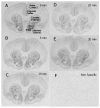Cocaine-induced mu opioid receptor occupancy within the striatum is mediated by dopamine D2 receptors
- PMID: 19699185
- PMCID: PMC2774811
- DOI: 10.1016/j.brainres.2009.08.035
Cocaine-induced mu opioid receptor occupancy within the striatum is mediated by dopamine D2 receptors
Abstract
Previous studies by our laboratory have demonstrated that the mu opioid receptor antagonist, CTAP, blocks the rewarding effects of cocaine when it is injected directly into the nucleus accumbens or ventral tegmental area (VTA). This finding suggests that cocaine is causing the release of endogenous opioid peptides which activate mu opioid receptors within the nucleus accumbens and VTA. The purpose of the present study was to characterize the dose-response and time-course of mu receptor occupancy following systemic cocaine administration and to determine if release of endogenous opioids by cocaine is mediated by activation of D1 or D2 dopamine receptors. Quantitative in vitro receptor autoradiography was used to measure the regional displacement of (3)H-DAMGO binding following cocaine administration. Adult male Sprague-Dawley rats were given intraperitoneal (i.p.) injections of cocaine and their brains were removed at various times and prepared for mu opioid receptor quantitation. To determine the role of dopamine D1 and D2 receptors in the effect of cocaine on mu receptor occupancy, rats were injected with the selective D1 or D2 receptor antagonists SCH23390 or eticlopride prior to cocaine. For all studies, (3)H-DAMGO binding to mu opioid receptors was measured in the nucleus accumbens, caudate putamen, frontal cortex, olfactory tubercle and VTA. Results demonstrate that cocaine administration caused a time- and dose-dependent reduction in (3)H-DAMGO binding within the nucleus accumbens core and shell. The reduction in mu receptor binding was attenuated by pretreatment with eticlopride. These results suggest that cocaine, acting via D2 dopamine receptors, can cause the release of an endogenous opioid peptide that binds to mu opioid receptors within the nucleus accumbens.
Figures





Similar articles
-
Cocaine reward and hyperactivity in the rat: sites of mu opioid receptor modulation.Neuroscience. 2008 Jul 17;154(4):1506-16. doi: 10.1016/j.neuroscience.2008.04.063. Epub 2008 May 3. Neuroscience. 2008. PMID: 18550291 Free PMC article.
-
Cocaine alters mu but not delta or kappa opioid receptor-stimulated in situ [35S]GTPgammaS binding in rat brain.Synapse. 2003 Jan;47(1):26-32. doi: 10.1002/syn.10148. Synapse. 2003. PMID: 12422370
-
The effect of repeated administration of morphine, cocaine and ethanol on mu and delta opioid receptor density in the nucleus accumbens and striatum of the rat.Neuroscience. 1999;91(3):971-7. doi: 10.1016/s0306-4522(98)00637-x. Neuroscience. 1999. PMID: 10391475
-
Dopamine reward circuitry: two projection systems from the ventral midbrain to the nucleus accumbens-olfactory tubercle complex.Brain Res Rev. 2007 Nov;56(1):27-78. doi: 10.1016/j.brainresrev.2007.05.004. Epub 2007 May 17. Brain Res Rev. 2007. PMID: 17574681 Free PMC article. Review.
-
From taste hedonics to motivational drive: central μ-opioid receptors and binge-eating behaviour.Int J Neuropsychopharmacol. 2009 Aug;12(7):995-1008. doi: 10.1017/S146114570900039X. Epub 2009 May 12. Int J Neuropsychopharmacol. 2009. PMID: 19433009 Review.
Cited by
-
Striatal cue-reactivity and neurotransmitter function in gambling disorder.J Behav Addict. 2025 May 28;14(2):997-1009. doi: 10.1556/2006.2025.00041. Print 2025 Jul 2. J Behav Addict. 2025. PMID: 40434828 Free PMC article.
-
Effects of amphetamine on the human brain opioid system--a positron emission tomography study.Int J Neuropsychopharmacol. 2013 May;16(4):763-9. doi: 10.1017/S1461145712000818. Epub 2012 Aug 29. Int J Neuropsychopharmacol. 2013. PMID: 22932428 Free PMC article. Clinical Trial.
-
Epigenetic regulation of beta-endorphin synthesis in hypothalamic arcuate nucleus neurons modulates neuropathic pain in a rodent pain model.Nat Commun. 2023 Nov 9;14(1):7234. doi: 10.1038/s41467-023-43022-7. Nat Commun. 2023. PMID: 37945654 Free PMC article.
-
Pleasure systems in the brain.Neuron. 2015 May 6;86(3):646-64. doi: 10.1016/j.neuron.2015.02.018. Neuron. 2015. PMID: 25950633 Free PMC article. Review.
-
Chronic Back Pain Is Associated with Alterations in Dopamine Neurotransmission in the Ventral Striatum.J Neurosci. 2015 Jul 8;35(27):9957-65. doi: 10.1523/JNEUROSCI.4605-14.2015. J Neurosci. 2015. PMID: 26156996 Free PMC article.
References
-
- Adams DH, Hanson GR, Keefe KA. Cocaine and methamphetamine differentially affect opioid peptide mRNA expression in the striatum. J Neurochem. 2001;75(5):2061–70. - PubMed
-
- Ambrose LM, Unterwald EM, Van Bockstaele EJ. Ultrastructural evidence for co-localization of dopamine D2 and micro-opioid receptors in the rat dorsolateral striatum. Anat Rec A Discov Mol Cell Evol Biol. 2004;279:583–591. - PubMed
-
- Bloom FE, Rossier J, Battenberg EL, Bayon A, French E, Henriksen SJ, Siggins GR, Segal D, Browne R, Ling N, Guillemin R. Beta-endorphin: cellular localization, electrophysiological and behavioral effects. Adv Biochem Psychopharmacol. 1978b;18:89–109. - PubMed
-
- Branch AD, Unterwald EM, Lee SE, Kreek MJ. Quantitation of preproenkephalin mRNA levels in brain regions from male Fisher rats following chronic cocaine treatment using a recently developed solution hybridization assay. Brain Res Mol Brain Res. 1992;14(3):231–238. - PubMed
Publication types
MeSH terms
Substances
Grants and funding
LinkOut - more resources
Full Text Sources
Research Materials

